#vdlr – The "suburban sailfest" which is the biennial Volvo Dun Laoghaire Regatta this year (Thursday July 9th – Sunday 12th July) is marking its tenth anniversary with the sixth edition. It's a classic Irish mix of sailing sport at all levels aboard a wide variety of boats from many and often very distant places, combining to sail with the large home fleet in Dublin Bay in thirty different classes. And on each of the four days, colourful action afloat is followed ashore by a hectic pace of post-sailing celebrations in four waterfront clubs.
Three of these are venerable institutions with their origins in the midst of the 19th Century, and their homes in historic harbourside buildings each of which is, in its own way, an architectural masterpiece. And even the "newest" of the four waterfront clubs, the Dun Laoghaire Motor Yacht Club, is this year celebrating its Golden Jubilee.
The VDLR 2015 has much to live up to, but in the spirit of this youthful event in a mature setting, the people running it bring the necessary level of enthusiasm and expertise allied to unrivalled experience to maximize the enjoyment of a unique experience. W M Nixon casts an eye over something special.
"You have to remember that it's a regatta, not a championship. Enjoyment of sport comes first, and the purity of fierce competition second. But of course we're going to provide the best possible starts. And the intention is to have those starts leading into the best possible courses in the conditions prevailing."
"Yet the way we see it, people should be racing just as soon as possible after leaving the harbour. There's nothing which impairs simple sailing enjoyment so much as having to wait around in a perfectly good but maybe slightly fickle sailing breeze, hanging about in frustration while an overly-pernickety Race Officer dithers over setting the absolutely perfect start line".
If these were the words of some club's entertainment officer concerned with creating a good mood at some event no matter what happens in the racing, we'd treat them with some caution. But the speaker is not only a former and very actively sailing Commodore of two of Dun Laoghaire's most august yacht clubs, he's a helmsman/owner who has won championships to the top level in boats like the International Dragon and the International J/24.
He was also, in 1987, the lead helmsman on a 40-footer racing in the Irish Admiral's Cup team with such competence that he out-performed the legendary Lawrie Smith on a sister-ship during a tacking duel in the AC inshore events in the Solent, and then went on to be a lead helm when that boat won the Fastnet Race overall to conclude the series. More recently, he continues at the top level as one of the most successful owner-skippers in his Sigma 33 Offshore OD.
Welcome to the world of Tim Goodbody, sailing enthusiast extraordinaire, and the Chairman of the Organising Committee for Volvo Dun Laoghaire Regatta 2015. With all due respects to the three previous incumbents of this demanding post, he is the one with the most comprehensive record of personal sailing achievement in racing. So when he talks of "getting people out and racing just as soon as possible after leaving the harbour", we can be quite sure that the standards of start-line and course setting will be world class, as his stellar and continuing sailing career is allied to a formidable CV of involvement in sailing administration afloat and ashore.
Thus he was instrumental in devising the courses now used by Dublin Bay SC, and when Commodore of the Royal Alfred YC more than thirty years ago he led the way in developing the Superleague which set the standard as a season-long racing series at the time. Then as Commodore of the Royal Irish YC, he deftly combined the necessary roles of curator, committee man, accomplished owner-skipper and a public face of Dun Laoghaire sailing generally and one of Ireland's oldest and most distinguished clubs in particular.
With entries from 55 different clubs from all round the Irish Sea and further afield already in as the boats listed went through the 200 mark yesterday, a surge is expected ahead of the closing of the special early entry discount next Tuesday March 31st, and the VDLR 2015 administrative machine is fully in action to maximise an event which sees the old granite pond which is Dun Laoghaire Harbour embrace 21st century sailing.
It's pretty good going when you think that in two years time this totally artificial harbor will be shaping up to begin celebrating its Bicentenary, which can go on for as long as you wish, as the harbour was started in 1817, but it hadn't been sufficiently completed to stage a regatta until 1828.

The first regatta at Dun Laoghaire in 1828
Back then, some early yachtsmen staged match races between their often enormous yachts which tended to be based on the designs of the Revenue Cutters which were the fastest sailing vessels of their day. The prizes were appropriately enormous money purses of which a large proportion went to the sailors, so the professional crews raced with real aggression, and all sorts of devilish sabotage on the opposition was par for the course.
However, yacht racing was still in its infancy and while some owners were keen to do it, others – such as the Marquess of Anglesey who was one of the inspirers of this first event – were happier just to sail around displaying their extraordinary vessels to crowds which had never seen anything quite like it before.
The holding of more regular regattas in what was then Kingstown became part of the annual social season. Though the Royal Irish YC was the first club into being in 1831, it soon languished and it was the establishment of what eventually became the Royal St George in 1838 which made such annual regattas a key part of the annual high society season.
In other words, the events and personal displays ashore and along the waterfront were seen if anything as more important than the racing afloat. Then as now, the true sailing enthusiasts found this an annoying state of affairs, so they took to devising ways of making the sailing more important, rather than just a background to the various dramas and entertainments taking place ashore.
Doubtless the idea had been tried earlier, but in 1860 there was certainly an attempt at an early regatta week. By this time the Royal St George clubhouse had greatly expanded, and the Royal Irish was re-invigorated in its relatively-new1851-built clubhouse. Several days of racing were held with the local large-yacht flotilla enhanced by craft from the south coast. And then, as many of the vessels were headed back to Cork Harbour afterwards, the Admiral of the Royal Cork, Thomas G French, suggested an offshore race between Dublin Bay and Cork Harbour which duly took place, one of the world's very first genuine passage races.
In all, 15 yachts took part, but not all did so with the same urgency. Seven went away promptly as though it was really a race, but the remaining eight crossed the start line at different times within the next hour.
Ironically, the finish times two days later came down to a matter of minutes. The 90-ton schooner Kingfisher was first into Cork Harbour but a beat to the Royal Cork YC finish line at Cobh against the ebb was not at all to her liking, and the 80-ton cutter Peri took the lead. But then in tricky conditions in the harbour the even smaller 39-ton cutter Sybil managed to take the lead under the command of amateur skipper Henry O'Bryen, and hung onto to it to scrape across three minutes ahead of Peri with Kingfisher two minutes later.
Thus all the excitement and interest focused on the in-harbour stages. Back in Dublin Bay, this was proving the case with the new harbour, with one of the stars of Kingstown sailing drama at this period being Belfast linen magnate John Mulholland's legendary 1865-built schooner Egeria, which made a speciality of sweeping up to the finish lines right in close off the clubs with all sails set.
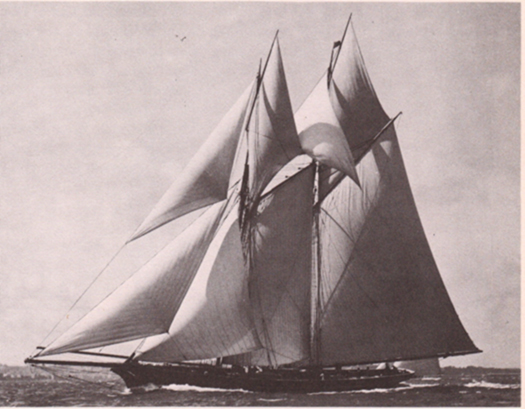
The successful 1865-built schooner Egeria, owned by John Mulholland from Belfast, was renowned for racing right up to the waterfront in Dun Laoghaire with all sail set
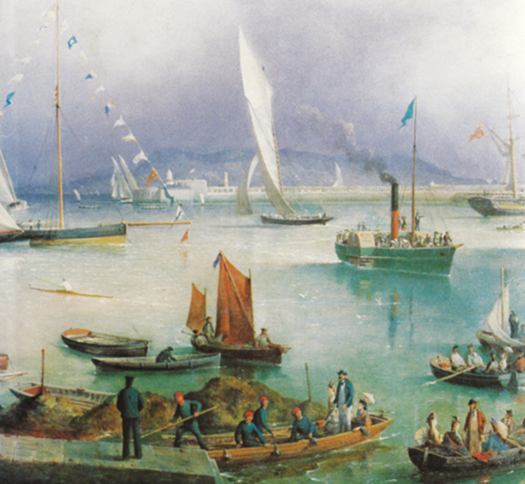
Classic Dun Laoghaire regatta scene by Richard Bridges Beechey. Courtesy RStGYC
The marine artist Richard Breeches Beechey made a speciality of recording these Dublin Bay dramas, and the enthusiastic owners were there to act their roles, no more so than John Jameson of the eponymous whiskey firm, whose successful cutter Irex was a star contender at major regattas all round the coasts of Britain and Ireland. When Irex was back in Dublin Bay, the crowds gathered, for in those days of much more limited entertainment, big boat racing was a must-see spectacle.
Yet at the same time there was something of a revolution going on in sailing, with the racing sport being codified in a movement largely led by the Royal Alfred YC, while small boat racing came centre stage when the Dublin Bay SC was established in 1884, with the one design concept making its appearance with the 13ft Water Wags in 1887.
This was all well and good for the underlying health of sailing. But for traditional yacht clubs with impressive premises which were ultimately there for the great and good to get involved with high end yachting at the height of the summer season, it was a mixed blessing, as each club's annual regatta tried to be all things to all sailing men and the few sailing women, while at the same time keeping the pavilion members happy.

In an age of less sophisticated entertainment, robust waterfront sports were an integral part of the Edwardian era regatta at the Royal St George YC. Photo courtesy Theo Harris
With yacht sizes decreasing, the spectacle and style which under-pinned a classic regatta were increasingly lacking, and while each club's stand-alone annual regatta continued as the centrepiece of its summer programme until well into the late 20th century, the increasing length and variety of the sailing season, and the easy accessibility of other sailing events for specific classes, meant that the traditional Dun Laoghaire regatta was becoming a threatened species.
So in the late 1940s when the newly-formed Irish Dinghy Racing Association was finding success with its annual Dinghy Week at popular sailing venues all round the coast, inevitably there began to be talk of a Regatta Week among the clubs in Dun Laoghaire, with the inevitable comparison to the success of Cowes Week being used to encourage the idea.
You will still hear the comparison to Cowes made from time to time, so let's get something off our chest. There is simply nowhere quite like Cowes. It's on an island, at the epicentre of a very interesting stretch of sailing water. And relatively few people live there. So when the annual Cowes Week is staged, almost every participant is a visitor. To a great extent, this is what makes it special.

The VDLR is ideal for a spot of family racing in all classes including the venerable Water Wags, but this serene mother and daughter crew combination aboard the family Wag is just ever so slightly different. Both are Olympic sailors. That's Cathy McAleavey (470 in 1988) on the spinnaker trim, and her daughter Annalise Murphy (Laser radial in 2012) is on the helm. Photo: VDLR
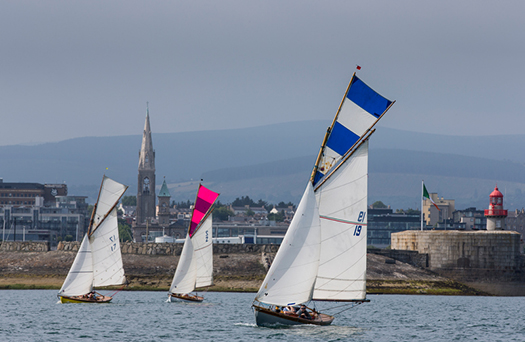
The Howth 17s – established 1898 – make the biennial pilgrimage across Dublin Bay to race in VDLR. Photo: VDLR
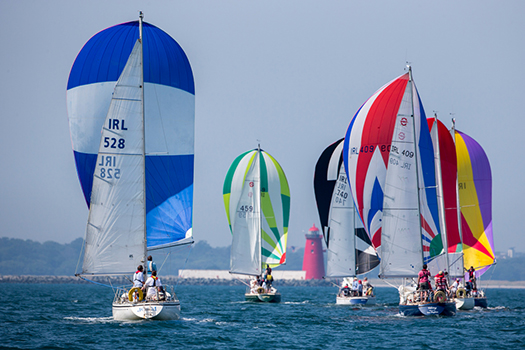
The Shipman 28s may be seen as handy little cruisers at other sailing entres, but in Dun Laoghaire they race as a one design class. Photo VDLR
But at many other sailing places in general, and in Dun Laoghaire in particular, you're right at the heart of a large and affluent resident population. The underlying atmosphere is inherently different, and any successful Dublin Bay event with a regatta flavour has to bear this quietly in mind if it's going to be a success.
Be that as it may, by the mid-1950s a Dun Laoghaire Regatta Week had been rather tentatively introduced, but the Irish economy was so depressed throughout that dismal decade that it was never a runaway success, and without any specifically Irish sailing media to record it, we know virtually nothing of what happened, and in any case it didn't last.
Yet boat numbers were increasing, so for a while the traditional annual Club Regatta had something of a heyday with the perfect balance between fleets afloat and the lack of too many distractions by other sports and interests ashore. For a brave new era, the annual regatta with the clubhouses bedecked in bunting was quite the thing.
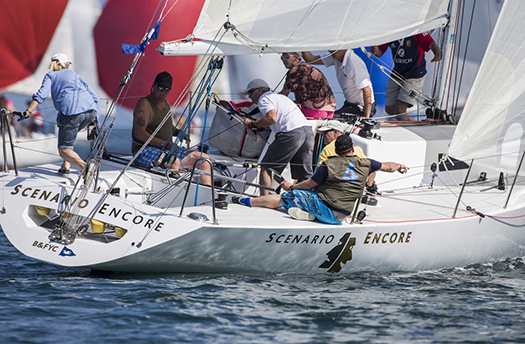
You don't absolutely have to go to Lancashire if you want to recruit a tattooed crew, but it helps. This is Scenario Encore from Blackpool & Fleetwood YC at VDLR 2013. Photo: VDLR

Ever get the feeling that everybody wants to be in the same place at once.......? Photo: VDLR
However, sailing was developing, and there came a new emphasis in the 1970s on offshore racing This in turn led to events like ISORA Week which could be tailored to match the established regatta programme. But then life patterns changed again, offshore racing was seen as almost anti-social, and club officers cast around for a re-shaping of the programme which would provide a compact event which had contemporary appeal for busy people who had many other interests to attend to and obligations to fulfill.
It was three or four years after the turn of the Millennium that the four Dun Laoghaire clubs tasked a working party of their junior flag officers with devising a regatta format which would suit the needs of the 21st Century. Somewhere out there, there has to be an individual original thinker who first proposed the key concept of a four day event evenly spread across all the clubs. We salute him or her, whomsoever they may be. But it went through so many modifications and mutations that the Dun Laoghaire Regatta, as it was first launched some time in late 2004 with the first one scheduled for 2005, had become a completely novel fixture, something carefully tailored to Dun Laoghaire as it has become today, taking into account the way of life of the people who sail from this great and unique port, and the expectations of the people who come to sail with them at their biennial suburban sailfest.
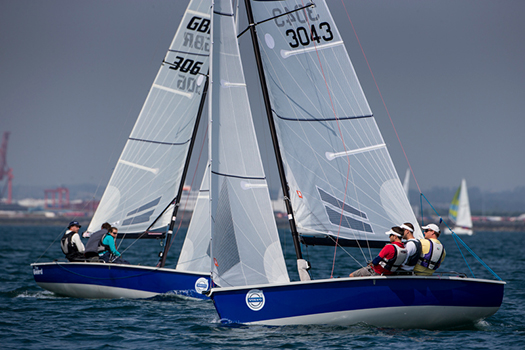
Perfect racing for the SB20s at VDLR 2013. Photo: VDLR
Even in its earliest forms it was such a novel concept that it clearly required someone very special to head up its nascent organising committee, but that was soon put on the right track with Brian Craig of the Royal St George YC put in charge as Chairman. Craig – the quintessential can-do backroom boy who so doggedly remains a behind-the-scenes figure – realised that careful diplomacy was needed if his new committee was going to avoid treading on established toes in the four existing club administration structures.
So he advertised for an administrative secretary with significant experience in office organisation and sailing, yet without any direct personal links to any of the Dun Laoghaire clubs. You'd have though this an almost impossible order with its very specific and unusual job-spec requirements, but they filled the bill precisely with Ciara Dowling. She'd grown up in the Irish countryside with no connection to boats or sailing, yet on any visit to Dun Laoghaire she'd felt drawn to the sport. However, it was while working in London as an office manager in her mid-twenties that she got involved afloat through a corporate outing for a rough day's sailing in the Solent, and was soon hooked while everyone else was sea-sick.
Working in sailing of any kind became her ambition, but it didn't always work out smoothly, yet she managed to put in a formidable amount of sea time and during a period back in Ireland she got signed up for one of the Irish crews (skippered by Tom McWilliam) in the Teachers Round Britain Challenge. By this stage she was finding sailing berths in Dublin Bay while moving between Ireland and London wherever there was boat-related work to be found, but at the time the notice for the Dun Laoghaire Regatta secretary was posted she was living in Howth and had become a member of Howth YC, but was not a member of any Dun Laoghaire club. That seemingly impossible job-spec outline had been hit on target.

Ciara Dowling with her gentlemen friends. The VDLR Secretary with the Chairmen who are (left to right) Tim Goodbody (2015), Adam Winkelmann (2011-2013), Phil Smith (2009), and Brian Craig (2005-2007).
Running what is now the Volvo Dun Laoghaire Regatta is not a full-time job, but as it rolls on through its biennial reincarnations, Ciara Dowling's unrivalled experience of the VDLR in particular and event management in general gives Dun Laoghaire sailing a very smooth management team for an event which can be constantly modified to suit changing tastes, while also competently dealing with a rush of last-minute entries if a good weather forecast comes along, as happened in 2013.
With the discount deadline looming next Tuesday, we'll leave fuller consideration of the fleet for a future date, but be sure that there are plenty of hot boats already in, boats of the calibre of Conor Phelan's Ker 36 Jump Juice from Cork which was pace-setting in Dublin Bay at the ICRA Nationals last year, and also already in the listings in what promises to be a very hot J/109 championship is Liam Shanahan's Ruth from the National, ISORA hotshot and oh-so-nearly winner of last year's Round Ireland.

The VDLR is one of the biggest annual gatherings for the historic IDRA 14 class. Photo: VDLR
And though the mood of the regatta is such that the organisers are very wary of declaring an overall winner, the feeling on the waterfront was that 2013's had been Nigel Biggs' classic Humphreys Half Tonner Checkmate, which has of course recently been sold to Dave Cullen of Howth and is a certain contender this summer.
It takes a while to get your head round the notion of 30 classes (or maybe now it's 31 with the RS Elites throwing their hats into the ring yesterday), and they'll be racing in six different areas under the direction of Race Officers of the quality of Jack Roy and Harry Gallagher.
In all, there are 150 volunteers involved, with a veritable fleet of support RIBs, so every day what mounts to a small navy is going to set out to go to sea to provide what is hoped will be some very special sport.
Tim Goodbody has only been in the chairman's job since the end of last summer, which he feels gives little enough time - he would recommend that any successor gets his feet under the table immediately after the St Patrick's Day holiday in the previous year. In other words, he reckons an absolute minimum of 15 months is required to maximize the success of this unique event.
But as he gets to grips with it, he is effusive in his praise for the support of the Dun Laoghaire Harbour Company, while the continued backing of Volvo through their people at Spirit Motors has kept the show on the road. The regatta's founding in 2005 saw it come into being just as the economy was starting to overheat, yet Volvo came aboard in 2007 and has stayed on as a great pillar of support.
But in the end, the success of it all will come down to you - the competitors. Let us hope that what we've outlined as the long and varied story of regattas in Dun Laoghaire will add to the richness of your experience, and the deeper meaning of an event of this type being held in Dublin Bay. It's no exaggeration to assert that racing in VDLR 2015, no matter what boat you may be sailing, is sailing the dream while being an active part of living history with a future dimension.
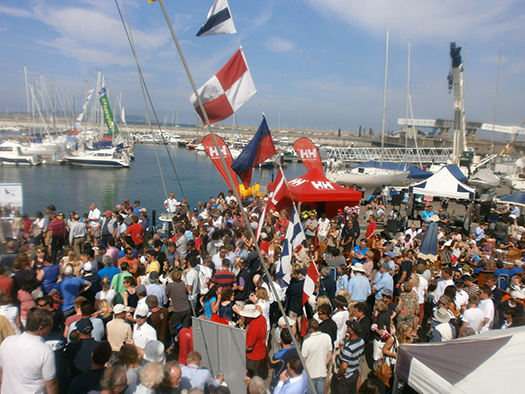
It has been described as "Leopardstown-on-Sea", but it's much better than that......Photo: VDLR
The 2015 Volvo Dun Laoghaire Regatta Programme (with a full entry list) will be published in late June as a supplement to Summer Afloat magazine
































































